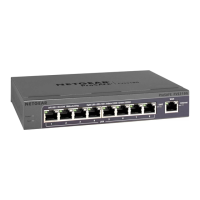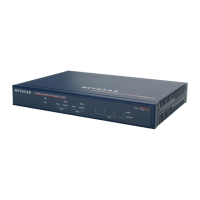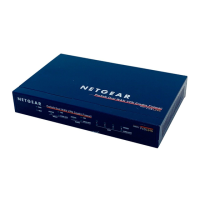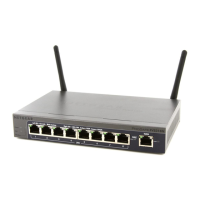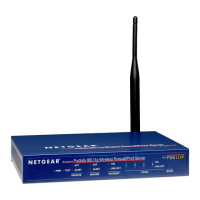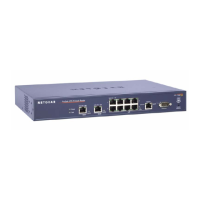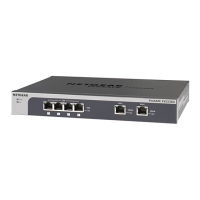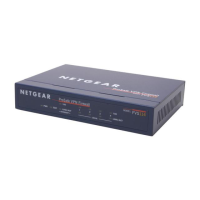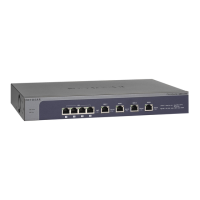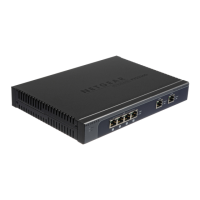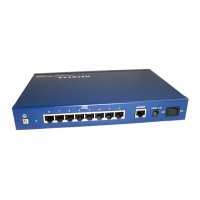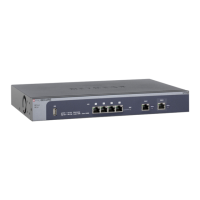
Do you have a question about the NETGEAR UTM5 and is the answer not in the manual?
Overview of the UTM appliance's main functionalities and technical attributes.
Describes the physical components, ports, and LEDs of the UTM models.
Outlines the essential steps for physically connecting and preparing the UTM for initial setup.
Details how to access the UTM's web management interface using a browser and default credentials.
Guides through configuring the initial LAN settings, including IP address and DHCP server options.
Explains how to configure the UTM's Internet connection settings, including ISP type and login details.
Describes how to automatically detect and configure WAN port connections for Internet access.
Provides instructions for manually configuring Internet connection parameters for DSL or Ethernet interfaces.
Details how to set up WAN modes like auto-rollover or load balancing for multi-WAN systems.
Explains how to manage virtual LANs, assign ports, and configure DHCP options for network segmentation.
Guides on setting up a dedicated DMZ port for hosting servers and managing traffic securely.
Covers the configuration of static routes and routing information protocol for network traffic management.
Covers creating firewall rules to control inbound and outbound traffic based on services, applications, or users.
Explains how to configure attack checks, VPN pass-through, and multicast pass-through for network security.
Details how to configure the Intrusion Prevention System (IPS) to detect and protect against network attacks.
Guides on configuring settings to protect the network's email communication from malware and spam.
Details how to configure web protocols, applications, and objects for malware scanning and protection.
Explains how the UTM scans encrypted HTTPS traffic by breaking and rebuilding SSL connections.
Covers creating exception rules for users and groups to allow or block web and application access.
Guides users through configuring IPSec VPN tunnels for both client and gateway setups using a wizard.
Provides step-by-step instructions for setting up gateway-to-gateway VPN tunnels using the wizard.
Explains how to configure keep-alive and Dead Peer Detection (DPD) features to maintain VPN tunnel stability.
Details how to enable and configure the PPTP server for remote user access via PPTP tunnels.
Describes the two levels of SSL VPN service for remote users: tunnel and port forwarding.
Facilitates SSL VPN client configuration through a step-by-step wizard for remote access.
Covers manual configuration and activation of SSL connections for remote access.
Describes how to create a custom portal page for remote users to access network resources.
Explains user authentication methods, including local database, RADIUS, and Active Directory.
Details the process of setting up authentication domains, groups, and user accounts for network access control.
Provides an overview of how Active Directory and LDAP work for domain authentication.
Covers managing digital certificates for authenticating VPN gateways, clients, and secure web access.
Focuses on controlling traffic through the UTM to optimize performance and prevent bottlenecks.
Covers tasks like changing passwords, managing configuration files, and updating firmware.
Explains how to modify administrator and guest account settings, including password changes and idle timeouts.
Guides on enabling and configuring remote management access via an SSL VPN connection.
Describes the process of updating the UTM's firmware from an update server or a downloaded file.
Details how to activate traffic metering for WAN ports to monitor or limit data traffic volume.
Details how to configure logging options, set up alerts, and manage event notifications for system events.
Explains how to use the Dashboard to monitor real-time traffic, security status, and system statistics.
Provides information on viewing various status screens like System, Network, and VPN connection status.
Provides instructions on how to query and download system logs for troubleshooting and analysis.
Covers initial checks for power, LEDs, and basic connectivity issues after powering on the UTM.
Offers solutions for common issues encountered when accessing the UTM's web management interface.
Provides steps to diagnose and resolve problems related to the UTM's Internet connection and ISP communication.
Explains how to reset the UTM to its original factory default settings and restore default credentials.
Details how to configure ADSL or VDSL settings for DSL Internet connection to the ISP.
Describes how to automatically detect and configure WAN port connections for Internet access.
Guides on manually setting up Internet connection parameters for DSL interfaces when DHCP auto-configuration fails.
Details how to set up WAN modes like auto-rollover or load balancing for multi-WAN systems.
Provides a general overview of the wireless module's capabilities and features.
Guides on configuring basic radio settings such as mode, country, and channel for the wireless module.
Covers methods to enhance wireless network security, including MAC address filtering and SSID broadcast control.
Explains how to configure the wireless access point settings, including SSID, security, and timers.
Provides factors to consider when planning a network with dual WAN ports for optimal configuration.
Details the steps involved in planning a network using a firewall with dual WAN ports.
Discusses IP addressing requirements for VPN tunnels in dual WAN configurations, including FQDN usage.
Lists the ReadyNAS models that are supported for integration with the UTM.
Provides instructions for installing the UTM add-on software onto a NETGEAR ReadyNAS device.
Details the steps to establish a connection between the UTM and the ReadyNAS for quarantine settings.
Explains the importance of two-factor authentication for enhancing security against cyber threats.
Outlines the advantages of two-factor authentication, such as enhanced security and regulatory compliance.
Describes NETGEAR's implementation of two-factor authentication using WiKID software.
Explains different categories of system log messages, including startup, reboot, and service events.
Details log messages generated by the content-filtering and security mechanisms.
Details log messages generated for LAN-to-WAN, LAN-to-DMZ, and DMZ-to-WAN traffic.
Lists the UTM's default configuration settings for router login, network, management, and firewall.
Provides detailed physical and technical specifications for the UTM models, including protocols, power, dimensions, and environmental requirements.
Outlines the FCC regulations and information for operating the device in the United States.
Details radio interference regulations from the Canadian Department of Communications for digital apparatus.

